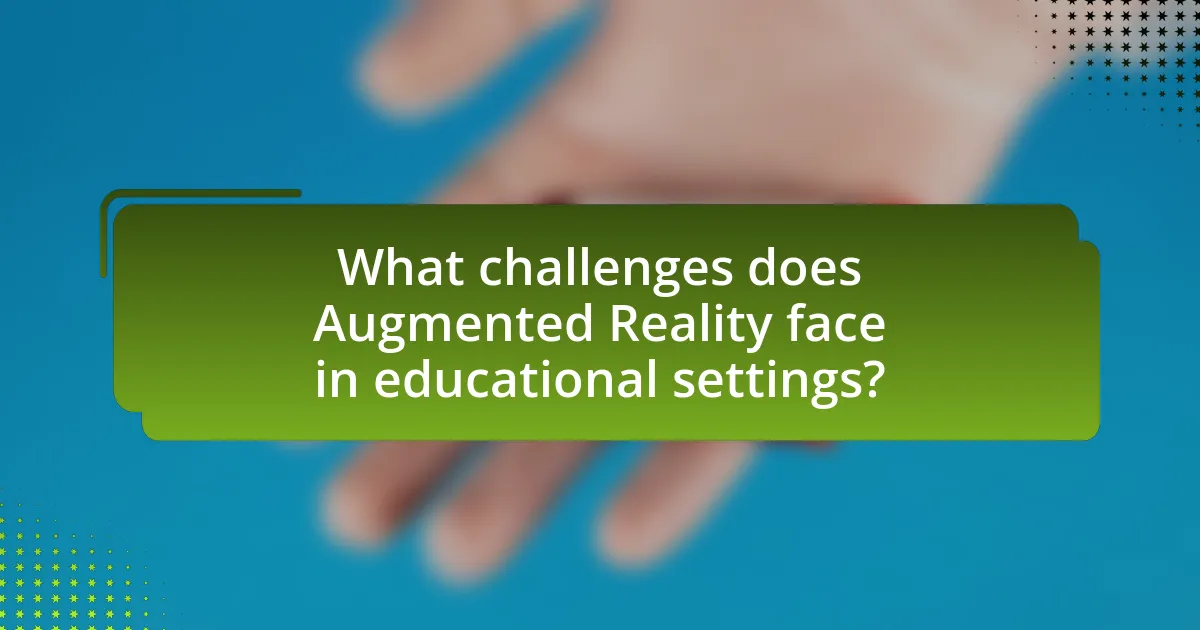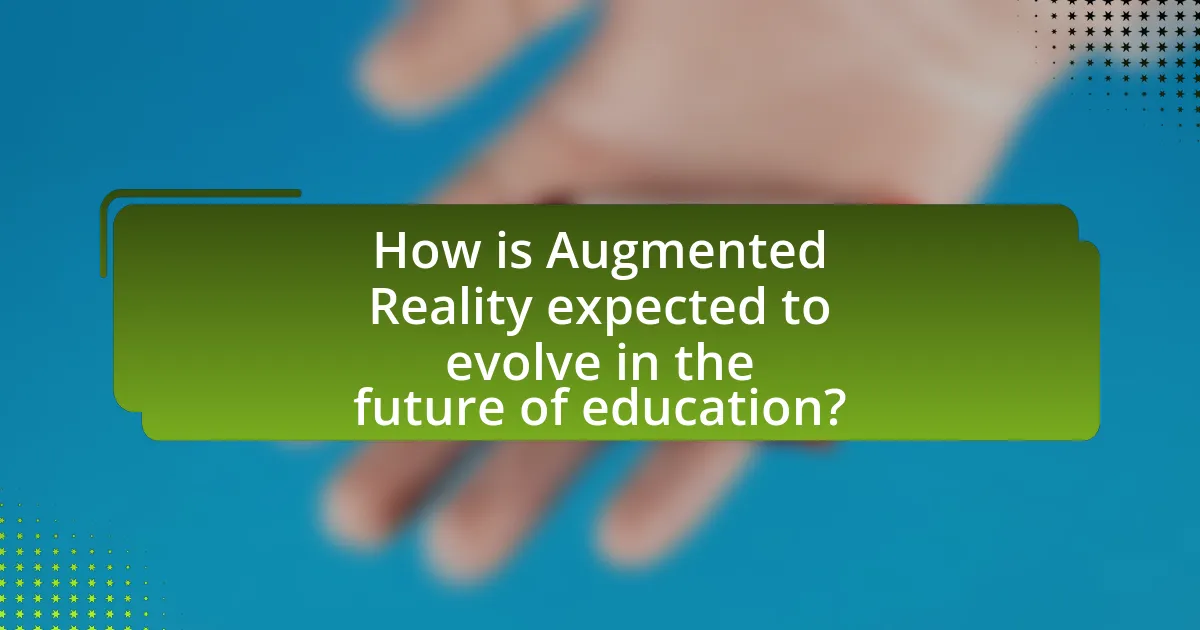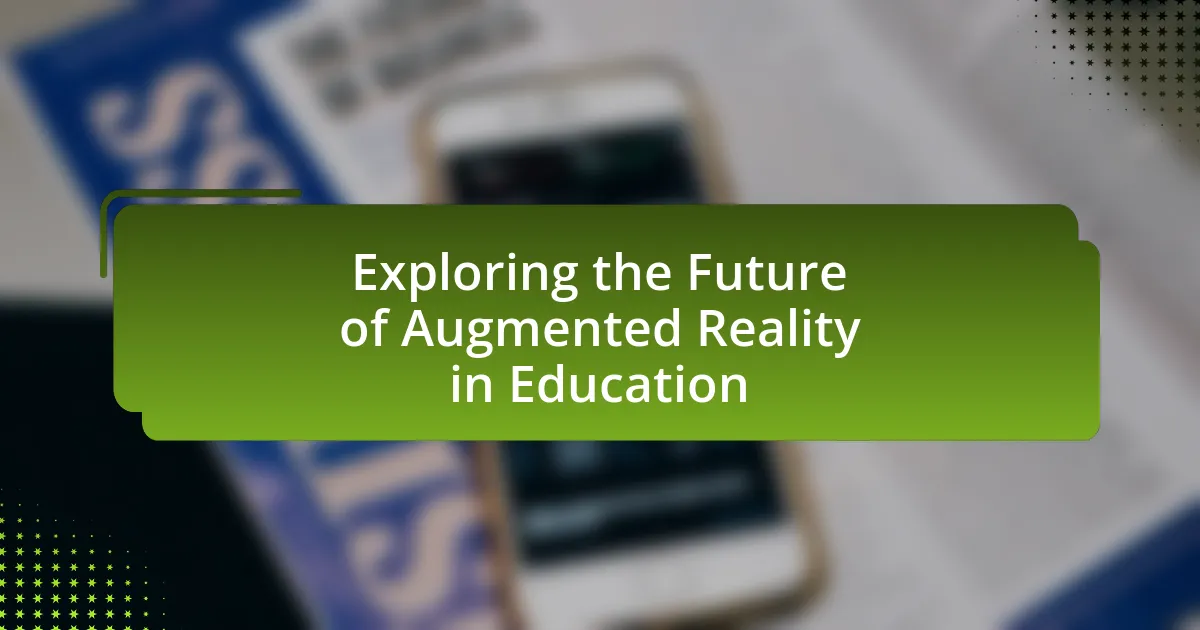Augmented Reality (AR) in education is an interactive technology that enhances learning by overlaying digital information onto the real world, improving student engagement and retention. The article explores how AR enhances learning experiences through immersive environments, the technologies involved, and its integration with traditional teaching methods. It also addresses the potential benefits, challenges, and ethical considerations of AR in educational settings, while providing insights into future trends and best practices for educators. Additionally, it highlights the importance of teacher training and accessibility in maximizing the effectiveness of AR tools in the classroom.

What is Augmented Reality in Education?
Augmented Reality (AR) in education is an interactive technology that overlays digital information, such as images, videos, and 3D models, onto the real-world environment to enhance learning experiences. This technology allows students to engage with educational content in a more immersive and interactive manner, facilitating better understanding and retention of information. For instance, a study published in the Journal of Educational Technology & Society found that AR applications can significantly improve students’ motivation and learning outcomes by providing contextualized learning experiences.
How does Augmented Reality enhance the learning experience?
Augmented Reality enhances the learning experience by providing interactive and immersive environments that facilitate deeper understanding of complex subjects. This technology allows students to visualize and manipulate 3D models, making abstract concepts more tangible. For instance, a study by the University of Maryland found that students using AR for anatomy lessons demonstrated a 20% improvement in retention compared to traditional methods. By engaging multiple senses, Augmented Reality fosters active learning, increases motivation, and supports diverse learning styles, ultimately leading to improved educational outcomes.
What technologies are involved in Augmented Reality applications for education?
Augmented Reality (AR) applications for education involve several key technologies, including computer vision, simultaneous localization and mapping (SLAM), depth tracking, and mobile devices. Computer vision enables the recognition of real-world objects and environments, allowing digital content to be overlaid accurately. SLAM technology helps in mapping the physical space and tracking the user’s position in real-time, which is essential for interactive experiences. Depth tracking enhances the realism of AR by providing information about the distance between objects, facilitating more immersive interactions. Mobile devices, such as smartphones and tablets, serve as platforms for AR applications, leveraging their cameras and sensors to deliver engaging educational content. These technologies collectively enhance learning experiences by integrating digital information with the physical world.
How do these technologies interact with traditional teaching methods?
Augmented reality (AR) technologies enhance traditional teaching methods by providing immersive, interactive experiences that engage students more deeply. For instance, AR can overlay digital information onto physical environments, allowing students to visualize complex concepts, such as anatomy or historical events, in a tangible way. Research by Wu et al. (2013) in “Augmented Reality in Education: A Review” highlights that AR can improve student motivation and learning outcomes by making lessons more interactive and visually stimulating. This interaction between AR and traditional methods fosters a blended learning environment, where educators can integrate hands-on activities with digital content, thereby enriching the educational experience.
What are the potential benefits of using Augmented Reality in education?
The potential benefits of using Augmented Reality (AR) in education include enhanced engagement, improved retention of information, and the ability to visualize complex concepts. AR technology allows students to interact with 3D models and simulations, making learning more immersive and stimulating. Research indicates that students using AR in educational settings show a 30% increase in retention rates compared to traditional learning methods, as reported in a study by Wu et al. (2013) in the journal “Educational Technology & Society.” This interactive approach not only fosters deeper understanding but also caters to various learning styles, thereby promoting inclusivity in the classroom.
How does Augmented Reality improve student engagement and motivation?
Augmented Reality (AR) improves student engagement and motivation by providing immersive, interactive experiences that enhance learning. AR allows students to visualize complex concepts in real-time, making abstract ideas more tangible and relatable. For instance, a study by the University of Maryland found that students using AR technology showed a 30% increase in engagement levels compared to traditional learning methods. This heightened engagement is attributed to the interactive nature of AR, which encourages active participation and exploration, leading to increased motivation to learn.
What impact does Augmented Reality have on knowledge retention?
Augmented Reality (AR) significantly enhances knowledge retention by providing immersive and interactive learning experiences. Research indicates that AR can improve retention rates by up to 70% compared to traditional learning methods, as it engages multiple senses and promotes active participation. A study published in the journal “Computers & Education” by Wu et al. (2013) found that students using AR technology demonstrated better recall and understanding of complex concepts, as the visual and contextual elements of AR facilitate deeper cognitive processing. This evidence supports the conclusion that AR positively impacts knowledge retention in educational settings.

What challenges does Augmented Reality face in educational settings?
Augmented Reality (AR) faces several challenges in educational settings, including high implementation costs, technological limitations, and the need for teacher training. High implementation costs can deter institutions from adopting AR technologies, as they often require significant investment in hardware and software. Technological limitations, such as the need for reliable internet connectivity and compatible devices, can hinder effective use in classrooms. Additionally, the lack of adequate teacher training can result in ineffective integration of AR into the curriculum, as educators may not be familiar with how to utilize these tools effectively. These challenges collectively impact the widespread adoption and successful application of AR in educational environments.
How can educators overcome the barriers to implementing Augmented Reality?
Educators can overcome the barriers to implementing Augmented Reality (AR) by investing in professional development and ensuring access to necessary technology. Professional development equips educators with the skills to effectively integrate AR into their teaching practices, as evidenced by studies showing that training increases confidence and competence in using new technologies. Additionally, providing access to AR tools and resources, such as mobile devices and AR applications, is crucial; research indicates that schools with adequate technology infrastructure see higher rates of successful AR implementation. By addressing these two key areas, educators can significantly reduce obstacles and enhance the educational experience through AR.
What are the common technical issues associated with Augmented Reality in classrooms?
Common technical issues associated with Augmented Reality (AR) in classrooms include hardware limitations, software compatibility problems, and connectivity issues. Hardware limitations often arise from insufficient processing power or outdated devices, which can hinder the performance of AR applications. Software compatibility problems occur when AR applications do not function properly across different operating systems or devices, leading to inconsistent user experiences. Connectivity issues, such as poor Wi-Fi or network instability, can disrupt the real-time data exchange necessary for effective AR experiences. These challenges can significantly impact the implementation and effectiveness of AR in educational settings.
How can training for teachers improve the use of Augmented Reality?
Training for teachers can significantly enhance the use of Augmented Reality (AR) by equipping them with the necessary skills and knowledge to effectively integrate AR tools into their teaching practices. When educators receive specialized training, they become more adept at designing AR experiences that align with curriculum objectives, thereby increasing student engagement and comprehension. Research indicates that teachers who undergo professional development in AR report higher confidence levels in utilizing these technologies, which correlates with improved student outcomes. For instance, a study published in the Journal of Educational Technology & Society found that teachers trained in AR applications were able to create more interactive and immersive learning environments, leading to a 30% increase in student participation and retention of information.
What ethical considerations arise with the use of Augmented Reality in education?
The ethical considerations arising from the use of Augmented Reality (AR) in education include issues of privacy, equity, and cognitive overload. Privacy concerns stem from the collection and use of personal data by AR applications, which can lead to unauthorized surveillance or data breaches. Equity issues arise as access to AR technology may not be uniform across different socioeconomic groups, potentially widening the educational gap. Cognitive overload can occur when AR content overwhelms students with information, hindering their learning process. These considerations highlight the need for careful implementation and regulation of AR technologies in educational settings to ensure they benefit all students without compromising their rights or well-being.
How does data privacy play a role in Augmented Reality applications?
Data privacy is crucial in Augmented Reality (AR) applications as these technologies often collect and process sensitive user data, including location, personal preferences, and interactions. The integration of AR in educational settings raises concerns about how this data is stored, shared, and utilized, potentially exposing students to risks such as unauthorized access or misuse. For instance, a study by the International Data Corporation (IDC) highlights that 70% of consumers are concerned about how their data is used in AR applications, emphasizing the need for robust privacy measures. Ensuring compliance with regulations like the General Data Protection Regulation (GDPR) is essential for AR developers to protect user data and maintain trust in educational environments.
What are the implications of accessibility in Augmented Reality for diverse learners?
Accessibility in Augmented Reality (AR) significantly enhances learning experiences for diverse learners by providing tailored educational tools that accommodate various needs. AR can offer visual, auditory, and kinesthetic learning opportunities, making content more engaging and easier to understand for students with different learning styles and disabilities. For instance, AR applications can include features like text-to-speech for visually impaired learners or interactive simulations for those who benefit from hands-on experiences. Research indicates that inclusive AR environments can improve engagement and retention rates among diverse learners, as they allow for personalized learning paths and real-time feedback. This adaptability is crucial in educational settings, where one-size-fits-all approaches often fail to meet the needs of all students.

How is Augmented Reality expected to evolve in the future of education?
Augmented Reality (AR) is expected to evolve in the future of education by becoming more integrated into curricula, enhancing interactive learning experiences, and personalizing education. As AR technology advances, it will enable immersive simulations that allow students to visualize complex concepts, such as anatomy or physics, in real-time. Research indicates that 70% of educators believe AR can significantly improve student engagement and retention rates, as it provides hands-on learning opportunities that traditional methods cannot offer. Furthermore, AR applications are anticipated to become more accessible and affordable, allowing schools to implement these tools widely, thereby transforming educational environments into dynamic learning spaces.
What trends are shaping the future of Augmented Reality in educational contexts?
Trends shaping the future of Augmented Reality (AR) in educational contexts include increased accessibility through mobile devices, enhanced interactivity in learning experiences, and the integration of AR with artificial intelligence. The proliferation of smartphones and tablets allows students to access AR applications easily, making immersive learning more widespread. Enhanced interactivity, such as gamified learning and real-time feedback, engages students more effectively, leading to improved retention rates. Furthermore, the integration of AR with AI enables personalized learning experiences, adapting content to individual student needs. Research indicates that these trends significantly enhance student engagement and learning outcomes, as evidenced by studies showing that AR can improve understanding of complex subjects by providing visual and interactive elements.
How might advancements in technology influence Augmented Reality’s role in education?
Advancements in technology will significantly enhance Augmented Reality’s role in education by improving accessibility, interactivity, and personalization of learning experiences. For instance, the development of more powerful mobile devices and faster internet connectivity allows students to access AR content seamlessly, facilitating immersive learning environments. Research indicates that immersive technologies can increase retention rates by up to 75%, as they engage multiple senses and provide real-time feedback. Furthermore, advancements in artificial intelligence can enable personalized learning pathways, adapting AR content to meet individual student needs, thereby increasing engagement and effectiveness in educational settings.
What predictions can be made about the integration of Augmented Reality in curricula?
Predictions about the integration of Augmented Reality (AR) in curricula indicate that AR will enhance interactive learning experiences and improve student engagement. Research shows that AR can facilitate experiential learning by allowing students to visualize complex concepts in a three-dimensional space, thereby increasing retention rates. For instance, a study by Wu et al. (2013) published in the Journal of Educational Technology & Society found that students using AR applications scored significantly higher on assessments compared to those using traditional methods. Furthermore, as AR technology becomes more accessible and affordable, its adoption in educational settings is expected to grow, leading to more personalized learning experiences tailored to individual student needs.
What best practices should educators follow when implementing Augmented Reality?
Educators should prioritize clear learning objectives when implementing Augmented Reality (AR) in the classroom. Establishing specific goals ensures that AR applications align with curriculum standards and enhance student engagement. Research indicates that AR can improve learning outcomes by providing interactive and immersive experiences, which can lead to better retention of information. For instance, a study published in the Journal of Educational Technology & Society found that students using AR for science education showed a 30% increase in knowledge retention compared to traditional methods. Additionally, educators should ensure that the technology is accessible to all students, providing necessary training and resources to facilitate effective use. By focusing on these best practices, educators can maximize the benefits of AR in educational settings.
How can educators effectively assess the impact of Augmented Reality on learning outcomes?
Educators can effectively assess the impact of Augmented Reality (AR) on learning outcomes by utilizing a combination of quantitative and qualitative evaluation methods. Quantitative assessments can include pre- and post-tests to measure knowledge gains, while qualitative methods can involve student feedback and observational studies to gauge engagement and understanding. Research indicates that AR can enhance learning by providing immersive experiences; for instance, a study by Wu et al. (2013) found that students using AR technology scored significantly higher on assessments compared to those using traditional methods, demonstrating the potential of AR to improve educational outcomes.
What resources are available for educators to explore Augmented Reality tools?
Educators can explore Augmented Reality (AR) tools through various resources such as online platforms, professional development courses, and educational websites. Notable platforms include Google Expeditions, which offers immersive AR experiences for classrooms, and Merge Cube, a hands-on AR tool that allows students to interact with 3D objects. Additionally, organizations like the International Society for Technology in Education (ISTE) provide guidelines and resources for integrating AR into teaching practices. Research indicates that AR can enhance student engagement and learning outcomes, making these resources valuable for educators seeking to implement innovative teaching methods.



